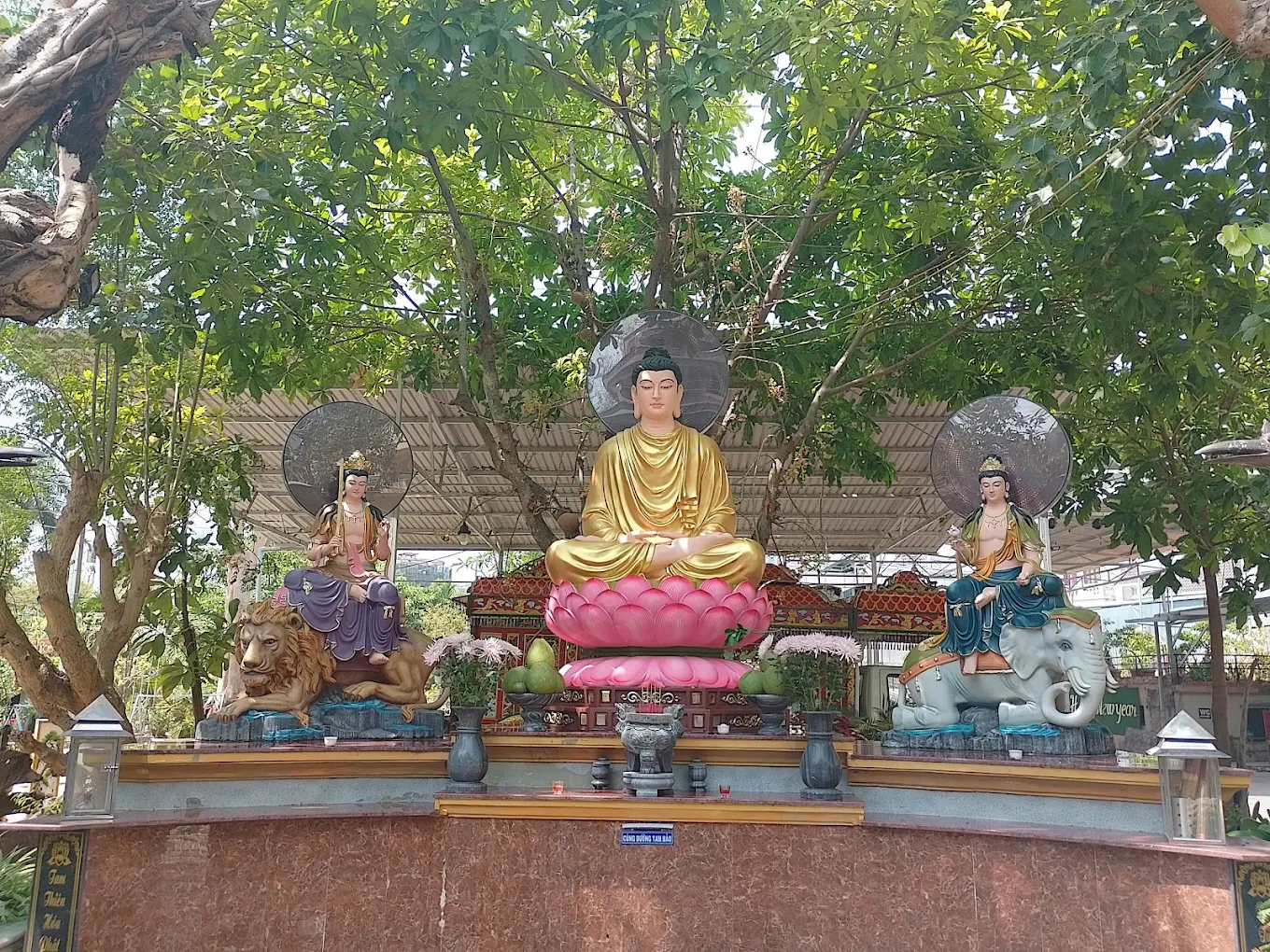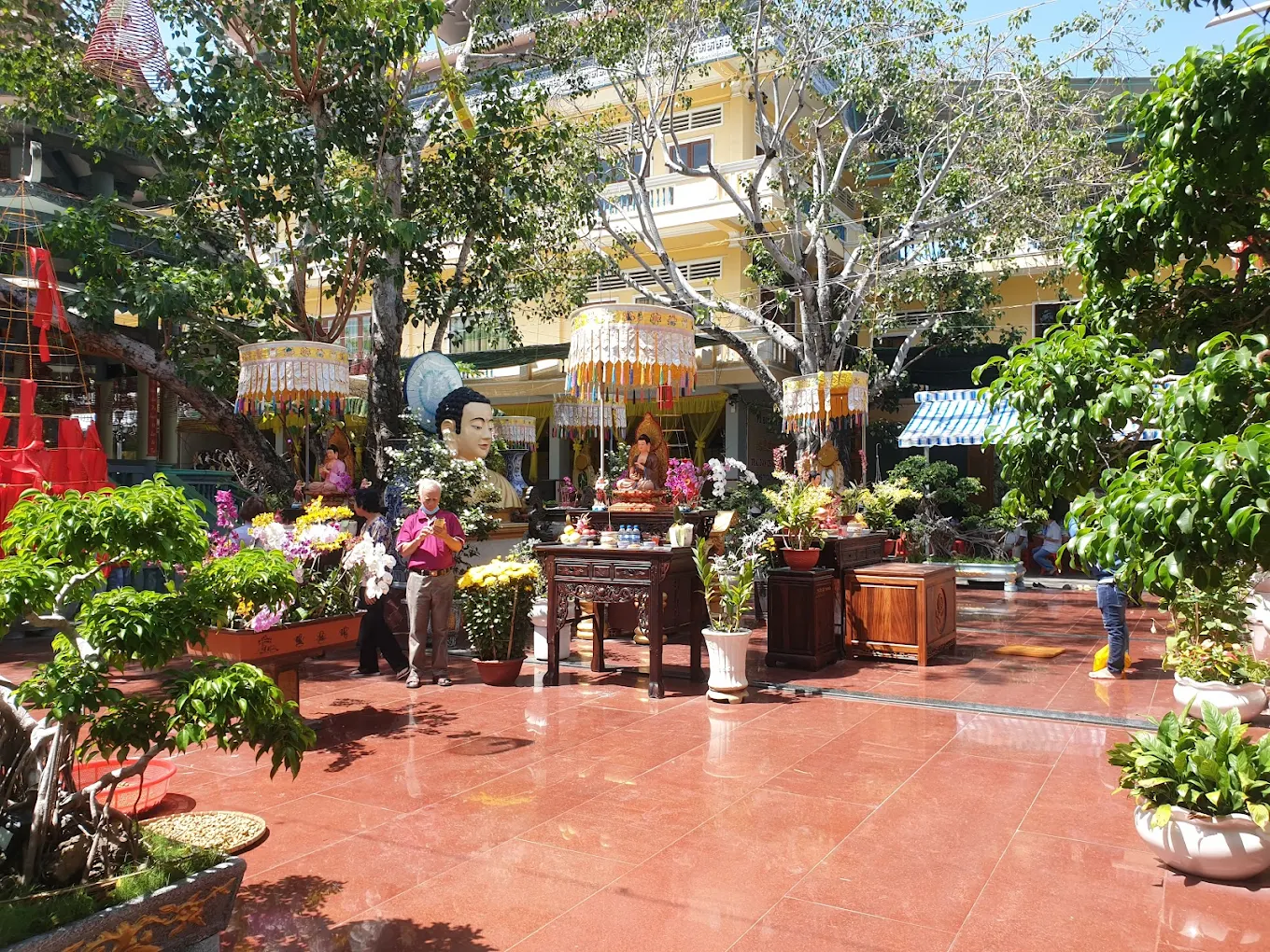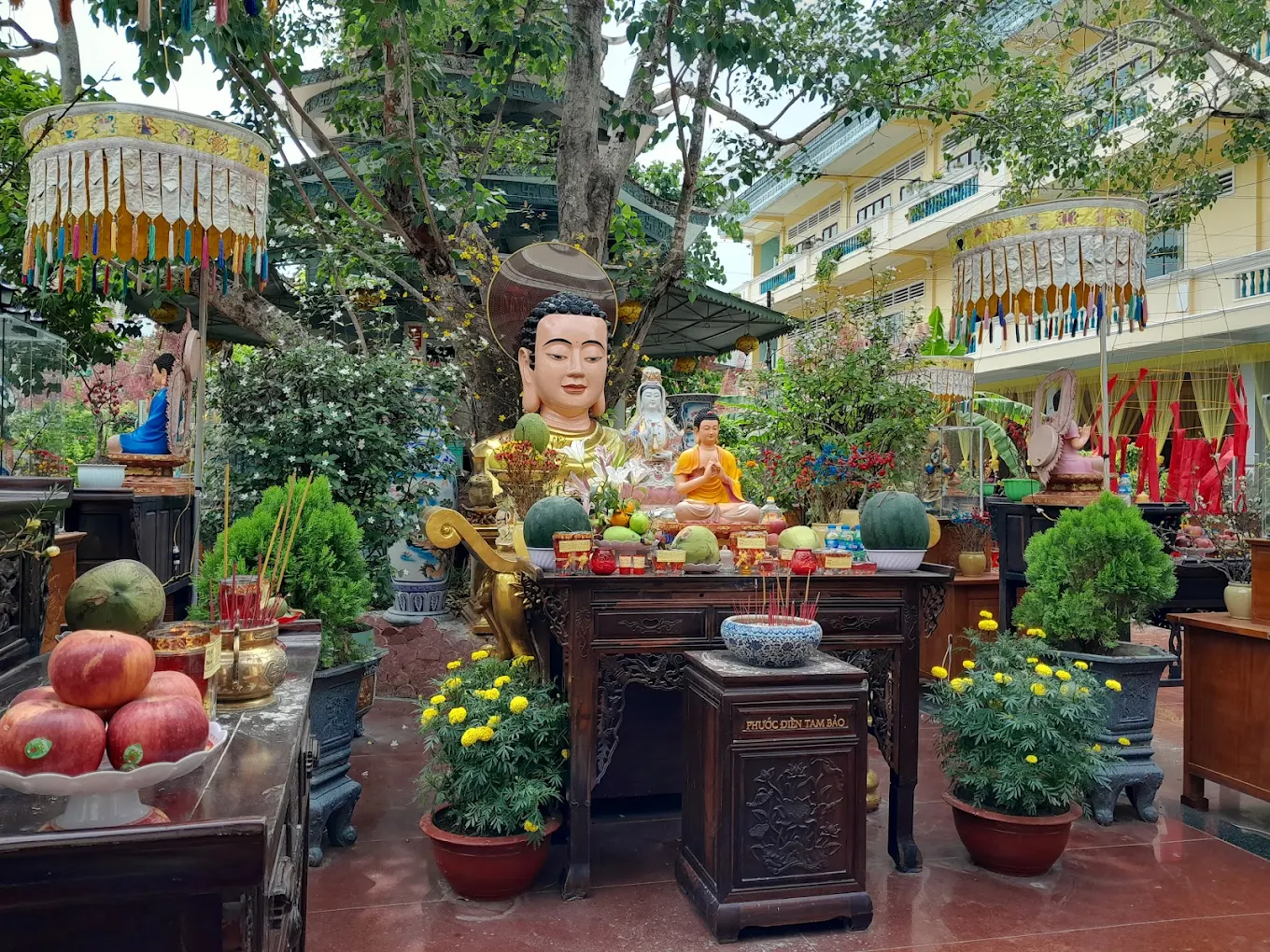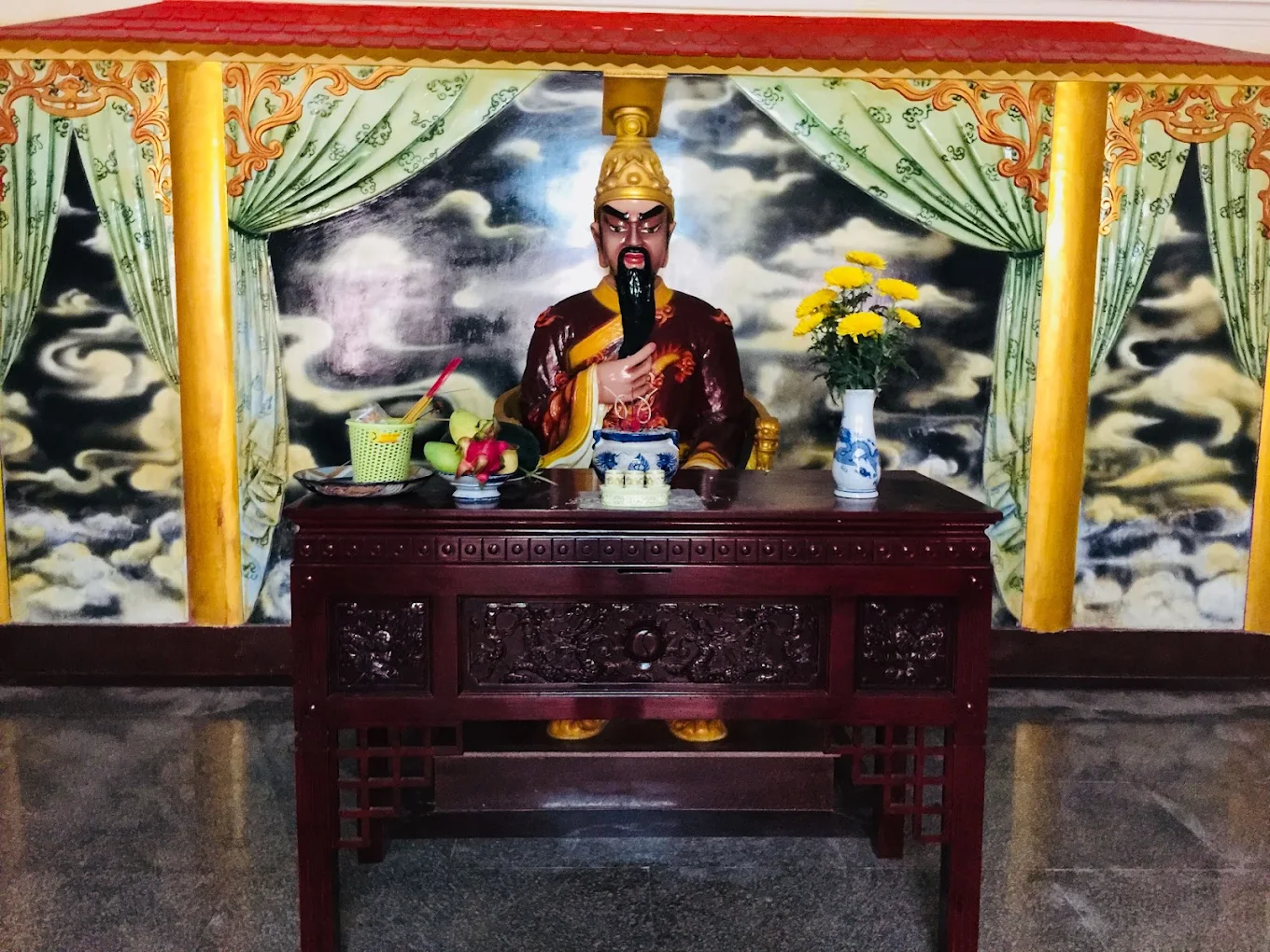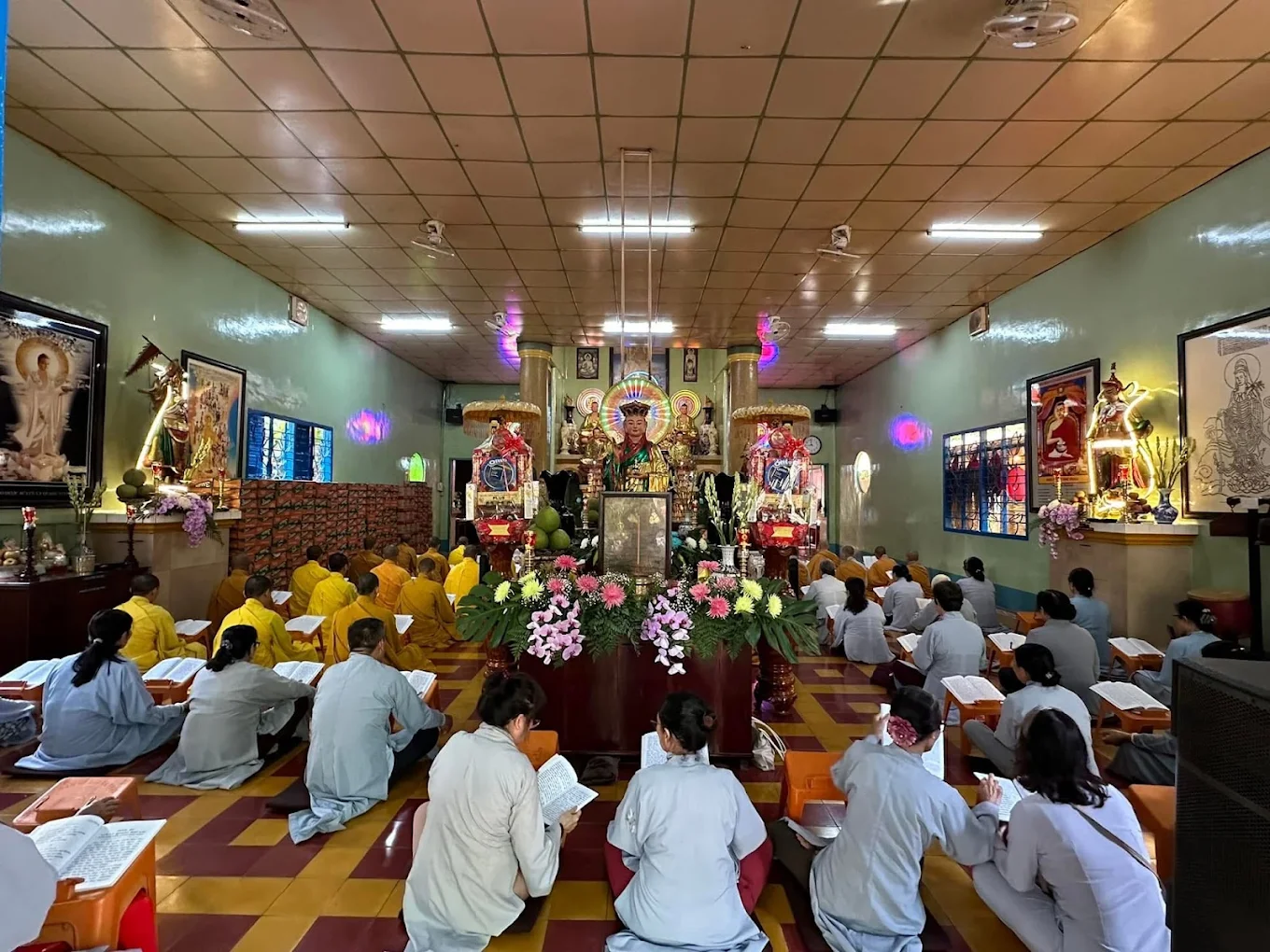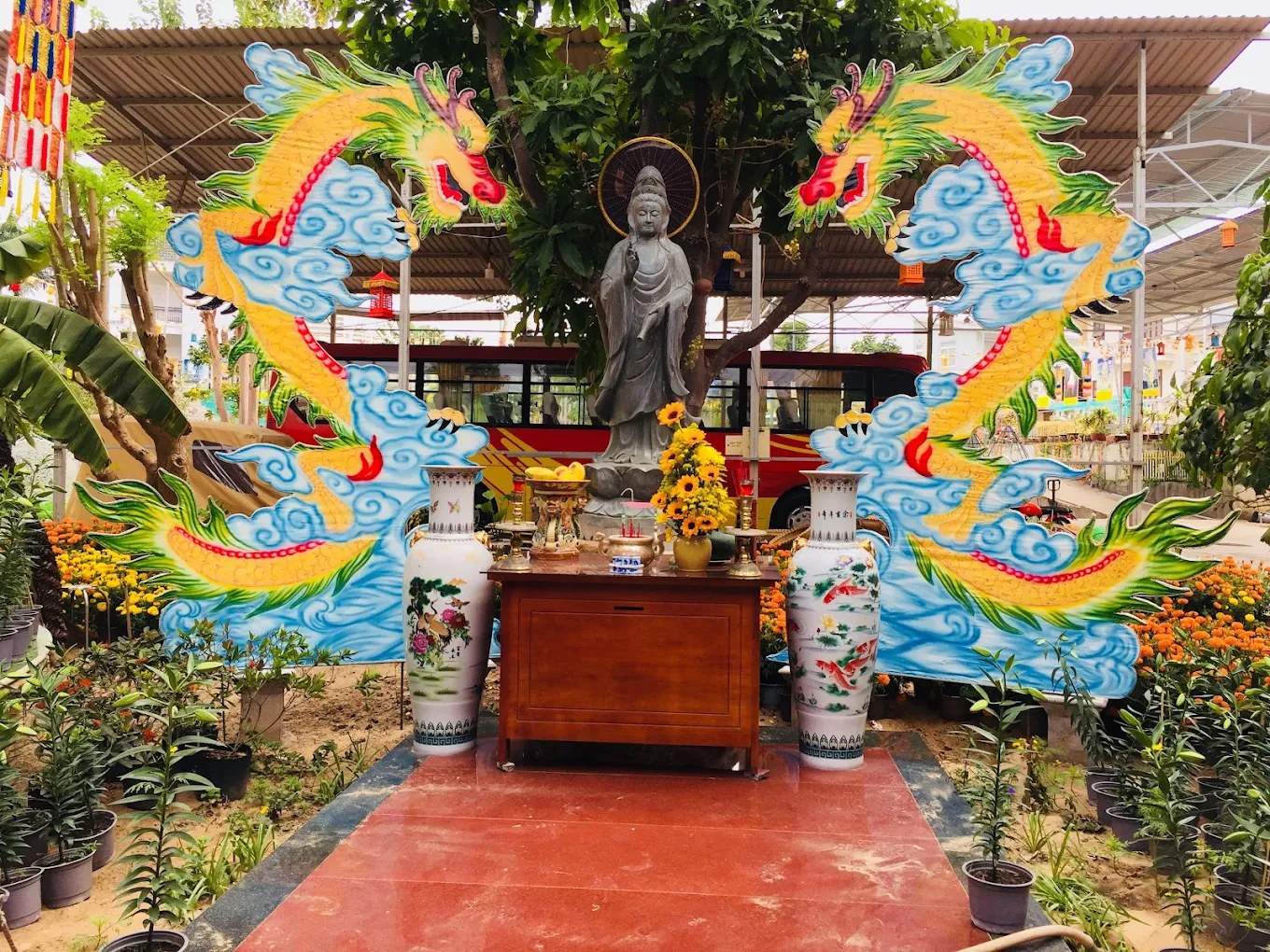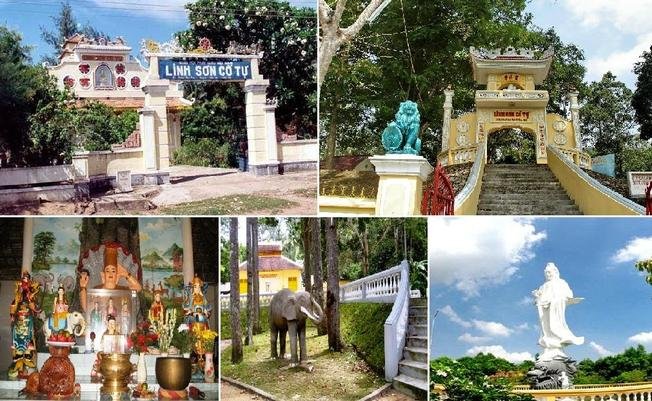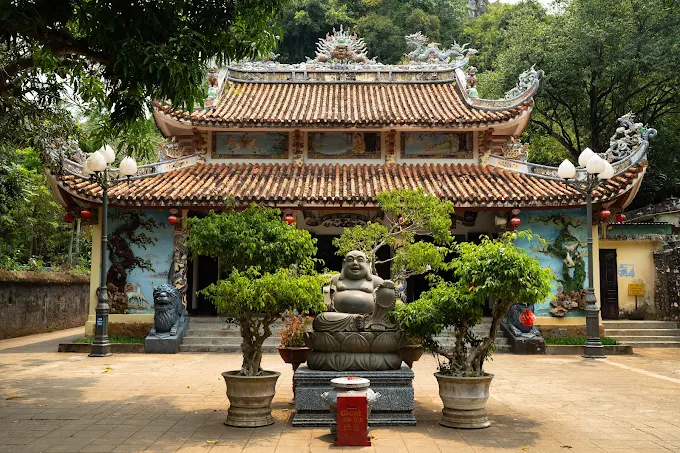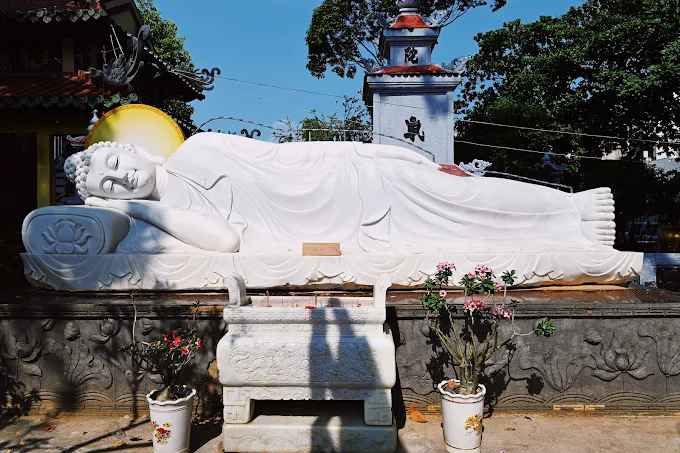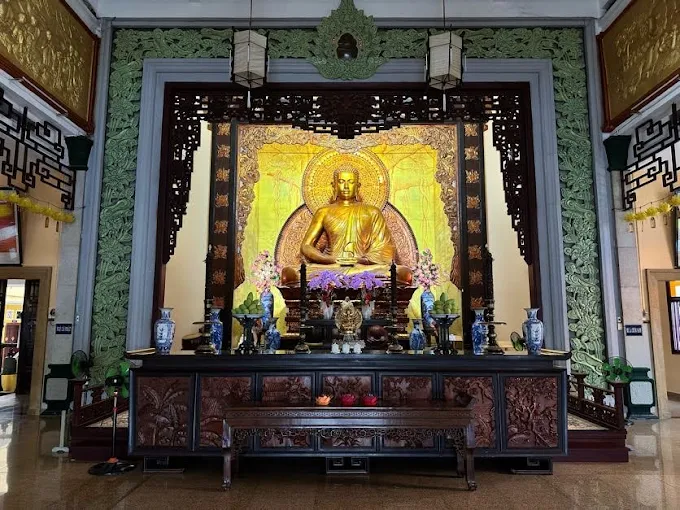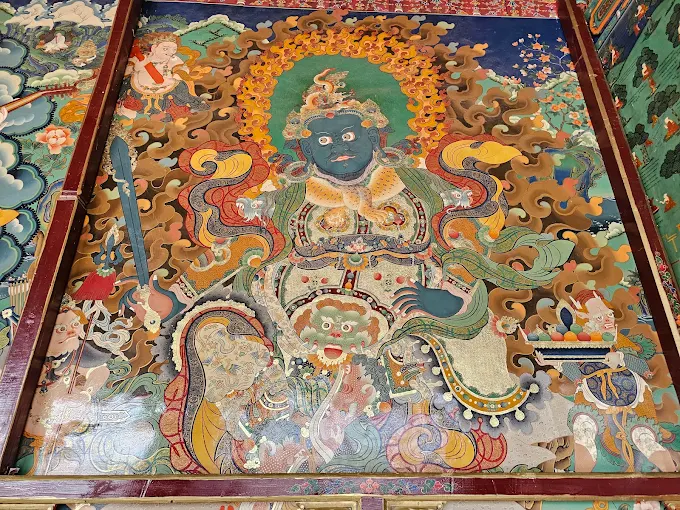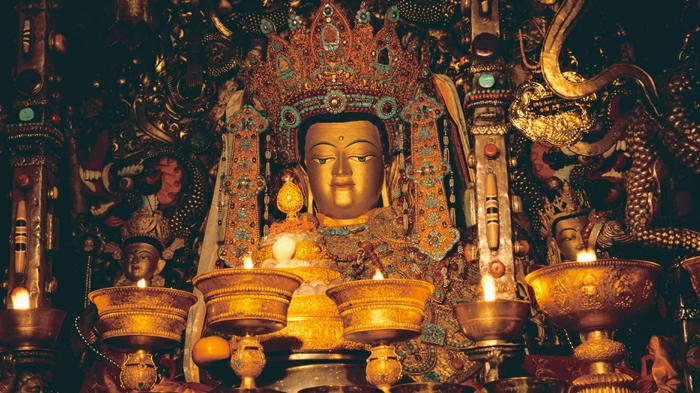Linh Son Ancient Pagoda: The Golden Echoes of Champa’s Sacred Craft
As dawn breaks over Vũng Tàu’s Thắng Tam ward, Linh Son Ancient Pagoda stirs gently, its modest main hall cradling a 1.2-meter golden Buddha statue, a luminous relic of Champa craftsmanship from over 1,600 years ago. The air hums with Amitabha chanting, devotees seeking rebirth in Amitabha’s Western Paradise, their voices blending with sandalwood incense and the rustle of lotus leaves in the courtyard pond. A flickering candle casts shadows on the wooden altars, etched with timeworn carvings, whispering tales of ancient devotion. This Mahayana sanctuary, Vũng Tàu’s oldest temple, invites all to uncover the timeless grace of Vietnam’s Champa heritage.
Overview and Significance
Introduction to Linh Son Ancient Pagoda
Linh Son Ancient Pagoda, nestled in the vibrant Thắng Tam ward of Vũng Tàu, stands as the city’s oldest Mahayana Buddhist temple, its 1.2-meter Champa-crafted golden Buddha statue embodying the serenity of the Pure Land tradition, which centers on devotion to Amitabha Buddha for rebirth in his Western Paradise. Located 1 kilometer from Vũng Tàu’s city center at 104 Hoàng Hoa Thám, this century-old sanctuary blends Vietnamese Mahayana elegance with Champa artistry, offering a quiet retreat amidst urban bustle. Its historic main hall, serene courtyard, and intimate lunar ceremonies make it a cultural treasure, drawing devotees, historians, and travelers into a realm of ancient spirituality.
Historical Journey
Linh Son Ancient Pagoda traces its origins to the early 20th century, with roots possibly extending further, making it Vũng Tàu’s oldest temple, though exact founding dates remain unverified. Built by local Mahayana Buddhists, it was designed as a spiritual haven for Thắng Tam’s community, centered around a 1.2-meter Buddha statue crafted by the Champa civilization over 1,600 years ago, discovered locally and enshrined as a relic. Community donations sustained its growth, with renovations in the 1970s preserving its wooden altars and Champa heritage. The pagoda’s survival through Vũng Tàu’s colonial and modern eras underscores its enduring significance.
Today, it remains a tranquil refuge, its history a testament to the interplay of Vietnamese and Champa cultures in coastal Vietnam.
- Patronage: Supported by local Mahayana Buddhists and Vietnam Buddhist Sangha.
- Milestones: Founded early 20th century; renovated in 1970s.
Cultural Significance
Linh Son Ancient Pagoda is a vital hub for Vũng Tàu’s Mahayana community, nurturing devotion to its Champa-crafted Buddha and Avalokitesvara. Its Pure Land practices, centered on Amitabha chanting, offer solace to urban devotees seeking peace. The pagoda hosts intimate cultural events, like lunar day ceremonies and Tet celebrations, drawing locals to its historic grounds.
Regionally, it connects with Mahayana communities in southern Vietnam, sharing Pure Land teachings. Globally, it attracts scholars studying Champa artistry and travelers drawn to its ancient relic, offering a glimpse into Mahayana’s compassion and Vietnam’s multicultural heritage.
- Mahayana Hub: Preserves Pure Land practices in Vũng Tàu.
- Cultural Role: Hosts lunar day ceremonies and Tet celebrations.
- Global Appeal: Attracts scholars and travelers for its Champa relic.
Unique Legacy
The pagoda’s Champa-crafted Buddha statue and historic main hall define its legacy, embodying Mahayana’s timeless grace. The 1.2-meter statue, a 1,600-year-old relic, and the hall’s timeworn wooden altars symbolize cultural endurance. Vietnamese lotus motifs and Champa-inspired stonework reflect a rare syncretism, while statues like Avalokitesvara anchor spiritual devotion.
This fusion of ancient artistry, spiritual relics, and cultural heritage earns Linh Son Ancient Pagoda its title as the “Golden Echoes of Champa’s Sacred Craft,” a living bridge to Vietnam’s past.
- Champa Buddha Statue: 1.2-meter gilded relic.
- Historic Main Hall: Timeworn wooden altars.
- Cultural Syncretism: Vietnamese and Champa influences.
Community and Global Impact
Linh Son Ancient Pagoda thrives as a communal heart for Thắng Tam’s Buddhist community. On lunar days, devotees gather before the Champa Buddha to chant and offer incense, their prayers resonating through the courtyard. Charity drives, supporting local artisans, strengthen community bonds, while Tet celebrations draw families with offerings to Avalokitesvara and red envelope exchanges.
Globally, the pagoda attracts historians and cultural enthusiasts studying Champa heritage. The Vietnamese diaspora supports preservation efforts, reinforcing cultural ties. Its ancient statue and intimate setting cement its global role as a Mahayana cultural gem.
- Local Engagement: Hosts prayers, charity, and festivals.
- Global Reach: Draws historians and cultural enthusiasts.
- Diaspora Support: Funded by Vietnamese communities abroad.
Architectural and Spiritual Features
Iconic Design
Linh Son Ancient Pagoda’s architecture blends Mahayana simplicity with Vietnamese and Champa elegance, its compact 500-square-meter complex centered on the main hall, courtyard, and lotus pond, framed by bodhi trees. Its muted palette—gold, brown, and red—evokes Mahayana’s timeless calm, with Vietnamese tiled roofs and Champa-inspired stonework creating a serene retreat amidst Thắng Tam’s urban pulse.
The main hall’s wooden altars and the courtyard’s lotus motifs, rooted in Mahayana and Champa traditions, craft a sacred oasis of devotion and historical reverence.
- Main Hall: Compact structure with Champa stonework.
- Vietnamese-Champa Aesthetic: Tiled roofs and lotus motifs.
- Urban Oasis: Contrasts with Thắng Tam’s bustle.
Key Structures
The main hall, housing the Champa-crafted Buddha and other statues, is the pagoda’s spiritual heart, its wooden altars glowing under soft light. The courtyard, with a lotus pond and bodhi trees, serves as a communal space for ceremonies. A small meditation pavilion, adorned with ceramic tiles, offers quiet reflection. A stone stupa in the courtyard, etched with lotus patterns, houses relics, adding historical depth.
These structures, blending spiritual and architectural heritage, create an intimate Mahayana sanctuary.
- Main Hall: Spiritual heart with Champa Buddha.
- Courtyard: Communal space with lotus pond.
- Stone Stupa: Relic-housed monument.
Worshipped Statues
The main hall’s Champa-crafted Buddha statue, a 1.2-meter gilded stone figure seated on a lotus pedestal, radiates ancient wisdom, its lifelike features a testament to Champa artistry from over 1,600 years ago. Shakyamuni Buddha, a smaller gilded statue, symbolizes enlightenment. Avalokitesvara, crafted in white porcelain with a nectar vase, offers compassion. Smaller shrines house Maitreya, in gold leaf with a joyful smile, symbolizing future prosperity, and Ksitigarbha (Địa Tạng [地藏]), in jade with a staff, guiding souls from suffering.
These statues, central to Mahayana worship, embody the pagoda’s spiritual essence, their iconography fostering devotion.
- Champa Buddha: 1.2-meter gilded stone relic.
- Shakyamuni Buddha: Gilded, symbolizing enlightenment.
- Avalokitesvara: Porcelain, offering compassion.
Materials and Techniques
The main hall, crafted with local stone and ceramic tiles, showcases Vietnamese artisans’ mastery, its Champa-inspired stonework reflecting ancient techniques. The Champa Buddha, carved from stone and gilded, preserves 1,600-year-old craftsmanship, with intricate facial details. Wooden altars, etched with lotus motifs, use teak rooted in Vietnamese traditions. Stone carvings of Buddhist tales adorn the courtyard, blending Vietnamese and Champa iconography, a hallmark of early 20th-century coastal architecture.
These materials, grounded in Vietnamese-Champa syncretism, create a visually striking and spiritually resonant sanctuary.
- Stone Hall: Ceramic-tiled with Champa stonework.
- Gilded Champa Buddha: Ancient stone with intricate details.
- Wooden Altars: Teak with lotus carvings.
Signature Elements
The Champa-crafted Buddha statue and historic main hall are the pagoda’s signature elements, their ancient grace symbolizing Mahayana’s enduring legacy. The 1.2-meter statue, glowing with golden radiance, and the hall’s timeworn altars anchor devotion. Vietnamese-Champa lotus motifs, etched in stone and wood, frame the spiritual narrative, enhancing the pagoda’s historical allure.
These elements, blending ancient relic and architectural heritage, define Linh Son Ancient Pagoda’s Mahayana identity, captivating all who visit.
- Champa Buddha: 1.2-meter relic of ancient artistry.
- Historic Main Hall: Timeworn anchor of devotion.
- Vietnamese-Champa Motifs: Lotus carvings in stone and wood.
Lesser-Known Features
The main hall’s ceiling, painted with faded lotus murals, forms a meditative canopy, often unnoticed in soft light. The courtyard’s stone lanterns, inspired by Vietnamese designs, cast gentle glows at dusk. Smaller shrines house ceramic sutra tablets, offering spiritual insight. A lotus pond near the entrance, with koi fish, adds serene beauty, reflecting the pagoda’s tranquil depth.
These subtle details enrich Linh Son Ancient Pagoda’s spiritual allure, rewarding attentive visitors.
- Lotus Murals: Faded meditative ceiling in the main hall.
- Stone Lanterns: Vietnamese-style courtyard glow.
- Lotus Pond: Serene entrance feature with koi.
Preservation and Evolution
The pagoda’s stone structures withstand Vũng Tàu’s coastal humidity, but the wooden altars require periodic restoration by artisans. Volunteers maintain the courtyard, stupa, and statue altars. Renovations in the 1970s preserved the Champa heritage, while adding the meditation pavilion to enhance accessibility, ensuring the pagoda’s century-old legacy endures.
These efforts keep Linh Son Ancient Pagoda a vibrant Mahayana temple, balancing tradition with modernity.
- Maintenance: Periodic altar restoration.
- Modern Updates: Meditation pavilion added in 1970s.
Rituals and Practices
Daily Sacred Rites
Each morning, Linh Son Ancient Pagoda resonates with Amitabha chanting, led by monks before the Champa-crafted Buddha statue, invoking rebirth in the Western Paradise. Devotees offer incense at the incense house, their prayers rising before Avalokitesvara’s compassionate gaze. The meditation pavilion’s bell tolls, grounding worshippers in devotion.
Lay followers present lotus flowers and candles to Bodhisattva statues, bowing in reverence. The lotus pond invites serene sutra recitation, fostering Mahayana’s universal salvation.
- Morning Chanting: Amitabha chanting before statues.
- Incense Offerings: Prayers for rebirth in the Pure Land.
- Sutra Recitation: Quiet pond-side devotion.
Unique Practices
The pagoda’s Pure Land devotion centers on Amitabha chanting, guiding devotees toward rebirth in the Western Paradise. Monks lead daily sessions before the Shakyamuni Buddha statue, cultivating mindfulness. Vegetarian offerings, placed in ornate bowls before Avalokitesvara, emphasize merit-making, reflecting Vietnamese Mahayana traditions.
On lunar days, monks perform relic-prayer ceremonies before the Champa Buddha, unique to Linh Son’s ancient heritage, honoring the 1,600-year-old statue and blessing Thắng Tam’s community for prosperity and peace.
- Pure Land Chanting: Daily Amitabha sessions.
- Vegetarian Offerings: Merit-making before statues.
- Relic-Prayer Ceremonies: Lunar rituals for Champa Buddha.
Festival Traditions
Tet, Vietnam’s lunar new year, transforms Linh Son with devotees offering red envelopes and lotus flowers before Avalokitesvara, as monks chant for blessings. Vu Lan, honoring filial piety, draws families pinning roses—red for living parents, white for the deceased—before the statues, with ancestral liberation prayers. Vesak, celebrating Buddha’s life, features candlelit processions and offerings to the Champa Buddha.
Lunar days attract devotees for special Amitabha chanting sessions, with statue veneration in the courtyard, uniting the community in reverence.
- Tet: Red envelope offerings and blessings before Avalokitesvara.
- Vu Lan: Rose-pinning and chanting for ancestors.
- Vesak: Candlelit processions for Champa Buddha.
Visitor Engagement
Visitors can light incense or offer lotus flowers before Avalokitesvara at the incense house, guided by monks on Mahayana etiquette. Amitabha chanting sessions, open to all, allow participation in Pure Land practices. During Tet, tourists may offer candles before the statues, immersed in festive rituals.
The courtyard fosters cultural exchange, with monks sharing insights on the Champa Buddha’s history, connecting locals and global visitors.
- Incense Lighting: Guided offerings before Avalokitesvara.
- Amitabha Chanting: Open Pure Land sessions.
- Festival Participation: Candle offerings during Tet.
Spiritual Community Roles
Linh Son’s monks, trained in Mahayana Pure Land teachings, lead chanting sessions and mentor devotees. They organize charity drives, supporting Thắng Tam artisans, strengthening community ties. Lay volunteers maintain the courtyard, stupa, and statue altars, fostering a sense of unity.
The abbot delivers sermons on compassion before Avalokitesvara, guiding initiatives. Buddhist devotee groups (Phật tử) organize Tet and Vu Lan events, enriching communal life.
- Monks: Lead rituals, mentor, and organize charity.
- Lay Volunteers: Maintain courtyard and statue altars.
- Buddhist Devotees: Organize Tet and Vu Lan celebrations.
Visitor Information
Navigating to Linh Son Ancient Pagoda
Linh Son Ancient Pagoda is located at 104 Hoàng Hoa Thám, Phường Thắng Tam, Vũng Tàu City, its modest main hall a landmark amidst urban bustle. The nearby Bãi Sau Beach, a 5-minute drive, offers scenic views, while Vũng Tàu’s city center, with landmarks like the Christ the King Statue, is a 5-minute taxi ride. The pagoda blends historic calm with urban accessibility.
From the city center, visitors can walk or take a short taxi via Hoàng Hoa Thám, easily spotting the pagoda’s tiled roof near Thắng Tam’s markets.
- Landmark: Main hall on Hoàng Hoa Thám.
- Nearby Sites: Bãi Sau Beach (2 km), Christ the King Statue (1 km).
- Central Access: 5-minute taxi from city center.
Address of Linh Son Ancient Pagoda
- Vietnamese: Linh Sơn Cổ Tự, 104 Hoàng Hoa Thám, Phường Thắng Tam, Thành phố Vũng Tàu, Tỉnh Bà Rịa – Vũng Tàu, Việt Nam.
- English: Linh Son Ancient Pagoda, 104 Hoàng Hoa Thám, Thắng Tam Ward, Vũng Tàu City, Bà Rịa – Vũng Tàu Province, Vietnam.
Visiting Hours and Etiquette
Linh Son Ancient Pagoda is open daily from 6:00 AM to 6:00 PM, with early mornings offering a peaceful setting for chanting before the statues. The main hall, courtyard, and meditation pavilion are accessible daily, with guided visits during lunar ceremonies. Visitors should plan 1 hour to explore the compact complex and reflect on its Champa heritage.
Dress modestly, covering shoulders and knees, and remove shoes before entering the main hall or meditation pavilion. Photography is permitted in the courtyard but requires permission inside shrines. Bow three times before statues to show respect, adhering to Mahayana customs.
- Hours: 6:00 AM–6:00 PM daily.
- Access: Main hall and courtyard open daily; guided during ceremonies.
- Etiquette: Modest dress, remove shoes, bow before statues.
Accessibility and Safety
The pagoda offers flat pathways to the courtyard and main hall, suitable for wheelchairs, with no significant steps limiting access. Volunteers assist during lunar ceremonies, guiding visitors to statue altars. The compact grounds accommodate mobility-impaired guests comfortably, though narrow shrine entrances may require care.
Thắng Tam is safe, but urban crowds may require caution—secure valuables. Stay on lit pathways at dusk, and bring light clothing for Vũng Tàu’s humidity.
- Accessibility: Flat pathways; narrow shrine entrances.
- Safety: Secure valuables; stay on lit pathways.
- Assistance: Volunteers available during ceremonies.
Amenities and Surroundings
Linh Son Ancient Pagoda provides restrooms, drinking water, and shaded benches in the courtyard. A kiosk sells incense and lotus flowers for statue offerings, supporting maintenance. The lotus pond and bodhi trees create tranquil spots, enhancing the spiritual ambiance.
Hoàng Hoa Thám offers phở stalls and local markets, while Bãi Sau Beach, a 5-minute drive, provides dining and relaxation. The nearby Christ the King Statue offers panoramic views, enriching the cultural experience.
- Amenities: Restrooms, water, incense kiosk.
- Surroundings: Phở stalls, Bãi Sau Beach (2 km).
- Sensory Highlights: Lotus scents, incense, urban hum.
Immersive Visitor Tips
Arrive at 6:00 AM to join Amitabha chanting before the Champa-crafted Buddha statue, fostering mindfulness. During Tet, offer a candle before Avalokitesvara and join a red envelope exchange, immersing in festive unity. Photograph the courtyard at sunrise, its lotus pond glowing, but avoid flash in shrines.
Explore Thắng Tam’s markets for bún bò Huế or visit Bãi Sau Beach for seafood. Attend on lunar days for relic-prayer ceremonies and statue veneration, deepening your connection.
- Morning Chanting: Join Amitabha sessions early.
- Sunrise Photography: Capture the courtyard’s glow.
- Festival Immersion: Offer candles during Tet.
